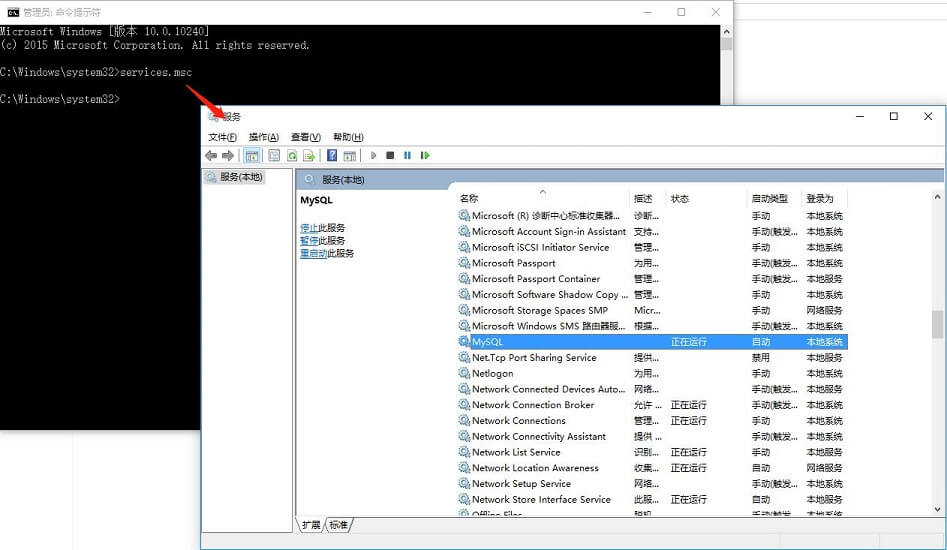# 方法1
[root@ecs-ce5a-0001 ~]# mysql -V
mysql Ver 14.14 Distrib 5.7.24, for Linux (x86_64) using EditLine wrapper
# 方法2
[root@ecs-ce5a-0001 ~]# mysql --help |grep Distrib
mysql Ver 14.14 Distrib 5.7.24, for Linux (x86_64) using EditLine wrapper
# 方法3
[root@ecs-ce5a-0001 ~]# mysql -uroot -pKoncendy@123
mysql: [Warning] Using a password on the command line interface can be insecure.
Welcome to the MySQL monitor. Commands end with ; or \g.
Your MySQL connection id is 12
Server version: 5.7.24-log MySQL Community Server (GPL)
Copyright (c) 2000, 2018, Oracle and/or its affiliates. All rights reserved.
Oracle is a registered trademark of Oracle Corporation and/or its
affiliates. Other names may be trademarks of their respective
owners.
Type 'help;' or '\h' for help. Type '\c' to clear the current input statement.
mysql> select version();
+------------+
| version() |
+------------+
| 5.7.24-log |
+------------+
1 row in set (0.00 sec)
# 方法4
mysql> status
--------------
mysql Ver 14.14 Distrib 5.7.24, for Linux (x86_64) using EditLine wrapper
Connection id: 12
Current database:
Current user: root@
SSL: Not in use
Current pager: stdout
Using outfile: ''
Using delimiter: ;
Server version: 5.7.24-log MySQL Community Server (GPL)
Protocol version: 10
Connection: Localhost via UNIX socket
Server characterset: utf8
Db characterset: utf8
Client characterset: utf8
Conn. characterset: utf8
UNIX socket: /data/mysql/mysql.sock
Uptime: 5 min 21 sec
Threads: 6 Questions: 293 Slow queries: 6 Opens: 195 Flush tables: 1 Open tables: 156 Queries per second avg: 0.912
--------------
mysql>
常见的错误
远程无法访问
??通常情况下,有两个可能性比较大的原因:
- bind-address没设置对,端口绑定到127.0.0.1上面去了
- 云服务器的3306端口没有做安全组规则开放(这个在本地服务器安装不会出现)
目录初始化问题
??启动时失败通过journalctl -xe查看发现如下的错入日志,一般出现这个错误表示my.cnf里指定的datadir不是一个空目录(有垃圾文件或者有之前初始化残留的文件);已经初始化,但没有成功,想再次初始化报错;这时需要清理这个目录之后重新尝试启动服务。
...: 2018-11-14T13:43:11.806347+08:00 0 [ERROR] --initialize specified but the data directory has files in it. Aborting.
日志权限的问题
??启动时失败通过journalctl -xe查看发现如下的错入日志,实际上就是写日志文件没有权限导致的错误。但是我在执行了[root@ecs-ce5a-0001 etc]# chmod -R 766 /var/log/mysql之后发现启动服务后还是会报下面的错误,很奇怪(因为766已经对应的是-rwxrw-rw-这个权限级别,可以读写了);后来将766调整为777才可以正常启动服务。(没完全弄明白为什么对日志目录要执行权限?)
...: 2018-11-14T13:44:17.230008+08:00 0 [ERROR] Could not open file '/var/log/mysql/error.log' for error logging: Permission denied
MSVCP140.dll缺失
??windows下出现的,在dos窗口运行mysqld --initialize-insecure,这时出现如下提示:
---------------------------
mysqld.exe - 系统错误
---------------------------
无法启动此程序,因为计算机中丢失 MSVCP140.dll。尝试重新安装该程序以解决此问题。
---------------------------
确定
---------------------------
??实际上这个问题是因为没有安装VC++2015版运行库导致的(Microsoft Visual C++ 2015 Redistributable),到如下下载地址 https://www.microsoft.com/en-us/download/details.aspx?id=53587 ,按照本机操作系统的位数确定下载的包,安装后即可解决此问题。
客户端连接MySQL 8报1251
??通过SQLyog或者Navicat连接MySQL发现报1251如下错误提示:

??百度了一下,原因是mysql8之前的版本中加密规则是mysql_native_password,在mysql8之后加密规则改成了caching_sha2_password;解决的方法有两种,一种是升级客户端驱动,一种是把mysql用户登录密码加密规则还原成mysql_native_password;因为咱们大多数都是自己想办法搞得客户端,所以就选择第二条路了;操作如下:
# Login
mysqladmin -u root -p
......
# Execute SQL
ALTER USER 'root'@'localhost' IDENTIFIED BY 'password' PASSWORD EXPIRE NEVER;
ALTER USER 'root'@'localhost' IDENTIFIED WITH mysql_native_password BY 'admin123';
FLUSH PRIVILEGES;
bk



